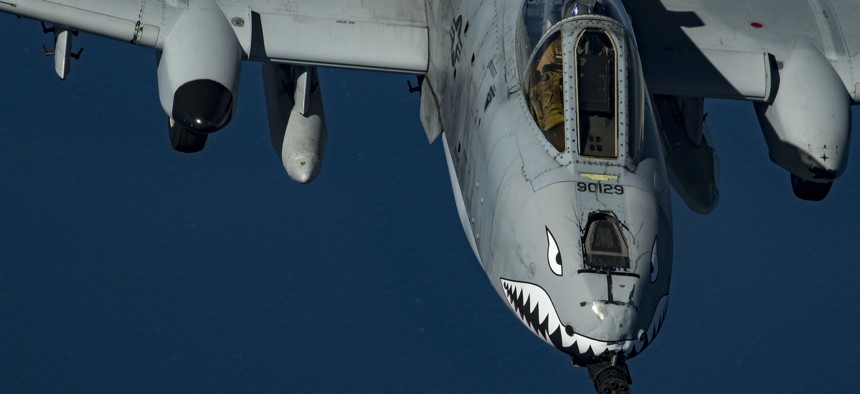
The U.S. Air Force is proposing to retired 42 of its A-10 Thunderbolt IIs. U.S. Air Force / Staff. Sgt. Daniel Snider
US Air Force Details Proposed Cuts to Planes, Flying Hours
2022 budget request would retire scores of fighters and tankers and cut thousands of flying hours to fund modernization.
The U.S. Air Force wants to cut thousands of flying hours and scores of combat aircraft to make room for modest increases in personnel and modernization spending, according to its fiscal 2022 budget request.
“The Air Force cannot successfully fight tomorrow’s conflicts with yesterday’s weapons,” the service said in its budget request. “We recognize the need for change in order to protect the American way of life.”
The service’s $156.3 billion budget request marks a $2.3 billion increase over 2021 enacted funds. If inflation stays around 4 percent, that would represent a real decrease of some 2.4 percent.
The Air Force is seeking $63.2 billion for operations and maintenance, up from $60.8 billion, but that number now includes overseas operations funds that have been shifted from the now-closed overseas contingency fund account. The request also includes $22.8 billion for procurement, down from $26 billion; and $28.8 billion for research, development, test, and evaluation, up from $26.6 billion.
In the plan submitted to Congress on Friday, the Air Force proposes retiring 42 A-10 Thunderbolt II ground attack aircraft, 20 C-130 aircraft of multiple variants, four E-8 Joint Surveillance Target Attack Radar System (JSTARS); 48 F-15 C/D and 47 F-16 C/D fighter jet variants; 18 KC-135R/T receiver-capable tankers and 14 KC-10 tankers.
It also cuts total flying hours from 1.24 million to 1.15 million.
One exception to the downsizing is one of the service’s oldest platforms, the B-52. If the Air Force’s plan holds, it will mean the military has relied on that airframe for almost 100 years.
Funding for the Cold War-era strategic bomber would increase from $483 million in 2021 to $716 million in 2022 to support “the most comprehensive modernization of the B-52 in its history, including new engines and radar systems,” the Air Force wrote. “These efforts will extend this 1950s-era bomber as a credible deterrent through 2050.”
The Air Force’s RDT&E request prioritizes continued development of the Ground Based Strategic Deterrent, increasing spending from $1.4 billion enacted in 2021 to $2.5 billion in 2022. Spending on the Long Range Standoff Weapon would rise from $385 million in 2021 to $609 million in 2022, and the service’s sixth-generation fighter program, Next-Generation Air Dominance, would increase from $902 million to $1.52 billion. Spending on the B-21 next-generation strategic bomber would rise modestly, from $2.84 billion in 2021 to $2.87 billion in 2022.
Lawmakers are already pushing back on some of the proposed retirements, particularly the C-130s, which are part of National Guard units across the country.
“The flexibility and readiness of the National Guard will be negatively impacted by any reduction in the C-130s,” said Rep. Cheri Bustos, an Illinois Democrat, at a Thursday House defense appropriations subcommittee hearing with Defense Secretary Lloyd Austin and Joint Chiefs Chairman Gen. Mark Milley.
“The Air Force doesn’t believe the current fleet of C-130s are needed in a high-end fight,” McCollum said, voicing opposition echoed by Illinois Democratic Senators Tammy Duckworth and Dick Durbin. “C-130s are instrumental to the protection of the homeland.”




